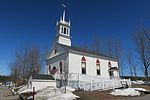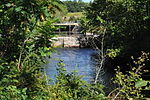Maplewood Farm (South Windham, Maine)
Buildings and structures in Windham, MaineFarms in Cumberland County, MaineFarms on the National Register of Historic Places in MaineGothic Revival architecture in MaineHistoric districts on the National Register of Historic Places in Maine ... and 6 more
Houses completed in 1738Houses in Cumberland County, MaineHouses on the National Register of Historic Places in MaineNRHP infobox with nocatNational Register of Historic Places in Cumberland County, MaineUse mdy dates from August 2023

Maplewood Farm, also known as the Anderson-Lord House, is an historic farm property on River Road in South Windham, Maine, United States. The 135-acre (55 ha) farm has been held in the same family since 1738, and features an architecturally distinctive Gothic Revival main house. It is also notable as a summer estate of John Anderson, a prominent mid-19th century Maine politician, and of his son John Farwell Anderson, a noted civil engineer and agriculturalist. It was added to the National Register of Historic Places in 1991.
Excerpt from the Wikipedia article Maplewood Farm (South Windham, Maine) (License: CC BY-SA 3.0, Authors, Images).Maplewood Farm (South Windham, Maine)
River Road,
Geographical coordinates (GPS) Address Nearby Places Show on map
Geographical coordinates (GPS)
| Latitude | Longitude |
|---|---|
| N 43.713055555556 ° | E -70.39 ° |
Address
River Road 72
04062
Maine, United States
Open on Google Maps








